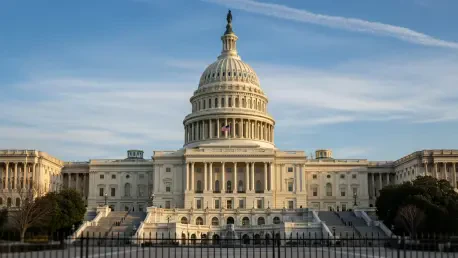In a defining moment for American governance, House Speaker Mike Johnson has issued an urgent summons for representatives to return to Washington, aiming to secure a vote that could end the longest government shutdown in U.S. history, a crisis that has paralyzed federal agencies and disrupted essential services. This decisive action comes on the heels of a significant Senate breakthrough on Sunday, where bipartisan support propelled a temporary funding deal forward. With federal agencies paralyzed and essential services teetering on the edge, the proposed stopgap measure offers a lifeline by extending funding through January 30. Such a move promises immediate relief for furloughed federal employees and vital programs like the Supplemental Nutrition Assistance Program (SNAP). The shutdown’s far-reaching consequences, from snarled air travel to uneasy financial markets, have intensified the pressure on lawmakers to act swiftly. As the nation watches, this legislative push represents not just a chance to restore normalcy but also a test of political will to address both immediate needs and lingering policy disputes.
Legislative Momentum and Immediate Actions
Bipartisan Senate Progress
The Senate’s recent 60-40 vote on Sunday stands as a critical turning point, breaking through weeks of partisan gridlock to advance a temporary funding measure that would sustain government operations until January 30. This bipartisan effort, which garnered support from seven Democrats, one independent, and numerous Republicans, reflects a rare moment of unity in a deeply divided political landscape. The deal prioritizes restoring essential services and ensuring back pay for federal workers who have endured financial hardship during the shutdown. Key figures, including Senate leaders from both parties, have hailed the vote as a necessary step to mitigate the damage inflicted on public trust and government functionality. While the agreement is temporary, it signals a willingness to compromise, setting a precedent for the House to follow suit. Speaker Johnson’s response to this development has been swift, underscoring the urgency of translating Senate progress into tangible action within the lower chamber.
House Preparations Under Pressure
With the Senate’s framework in place, Speaker Johnson has moved decisively to rally the House, calling members back to Washington with a commitment to provide 36 hours’ notice for a final vote once the deal is fully prepared. This rapid mobilization highlights the acute awareness of the shutdown’s toll on millions of Americans reliant on federal services. Beyond the immediate goal of reopening agencies, the House faces intense scrutiny to act without delay, as prolonged inaction risks further erosion of public confidence. President Trump’s public endorsement of the deal as “very good” adds a layer of political backing, though it also raises expectations for a seamless passage. The logistical challenge of reconvening representatives amidst ongoing disruptions only amplifies the stakes, as every hour of delay compounds the struggles of unpaid workers and shuttered programs. This moment tests the House’s ability to mirror the Senate’s resolve and deliver relief to a nation eager for resolution.
Policy Hurdles and Societal Ripples
Critical Healthcare Funding Dilemma
At the heart of the shutdown’s unresolved tensions lies the contentious issue of healthcare subsidies under the Affordable Care Act (ACA), with a pivotal vote postponed until December. Democratic leader Hakeem Jeffries has framed the extension of these subsidies as a non-partisan imperative, warning that failure to act could result in insurance premiums doubling for millions of Americans across political divides. This concern is echoed by policy analysts who highlight the economic burden such an outcome would place on middle- and low-income families. The delay in addressing this issue, while pragmatic in the short term to focus on reopening the government, carries significant risks, as inaction could fuel public discontent. The debate transcends party lines, with the potential to shape voter perceptions of both Democrats and Republicans as they navigate this complex policy challenge in the coming weeks.
Potential Paths to Bipartisan Resolution
Despite the uncertainty surrounding healthcare subsidies, there are glimmers of hope for a collaborative solution. Republican strategist Adolfo Franco has suggested that bipartisan support could emerge by December, pointing to a growing recognition among some GOP members of the subsidies’ importance to their constituents. This perspective offers a counterbalance to the skepticism expressed by critics who fear political posturing may derail progress. Experts caution that Democrats must balance their push for immediate action with strategic patience to build a coalition strong enough to pass a sustainable bill. The Kaiser Family Foundation’s projections of premium spikes add urgency to finding common ground, as the financial stability of millions hangs in the balance. If successful, such a compromise could serve as a model for addressing other contentious issues tied to the shutdown, reinforcing the value of dialogue over division in times of national crisis.
Aviation Sector in Crisis
The shutdown’s impact on air travel has been nothing short of catastrophic, with over 1,000 daily flight cancellations attributed to severe staffing shortages among unpaid air traffic controllers. These disruptions have stranded travelers, delayed critical shipments, and strained an industry already grappling with tight margins. Speaker Johnson has publicly recognized the immense pressure on these essential workers, noting their role in maintaining national safety and economic flow. Reports of overworked controllers highlight a human toll that statistics alone cannot capture, as stress and financial uncertainty threaten their ability to perform. The aviation crisis serves as a stark reminder of the shutdown’s cascading effects, touching nearly every American in some capacity. Resolving this issue requires not only funding but also targeted support to ensure the system can recover without further compromising safety or efficiency.
Controversial Proposals for Air Traffic Solutions
In response to the aviation chaos, President Trump has put forward a polarizing plan to address the air traffic controller shortage, proposing penalties for those who are absent while offering bonuses to those who continue to work under duress. This approach has sparked heated debate, with some viewing it as a pragmatic incentive to maintain operations, while others criticize it as punitive and insensitive to workers’ legitimate grievances. The proposal underscores the challenge of balancing immediate operational needs with long-term labor relations, as alienated workers could pose future risks to system stability. Meanwhile, industry stakeholders urge lawmakers to prioritize sustainable staffing solutions over temporary fixes, warning that public safety remains at stake. As the House prepares to vote, the resolution of this specific crisis within the broader shutdown context will likely influence public perception of the government’s handling of essential services.
Economic Indicators and Market Sentiment
Financial markets have become a barometer of public sentiment during the shutdown, displaying a mixed reaction that mirrors the nation’s uncertainty. Gains in the Nasdaq and S&P 500 suggest cautious optimism among investors, buoyed by the prospect of a government reopening through the Senate’s funding deal. However, the Dow’s relatively flat performance indicates persistent doubts about the longevity of any resolution without addressing underlying policy disputes. Analysts note that market fluctuations reflect broader concerns about consumer confidence and federal spending disruptions, which could have lasting economic consequences if not swiftly resolved. For businesses and individuals alike, the shutdown’s economic shadow looms large, with delayed contracts and reduced government services impacting daily operations. The House vote represents a critical opportunity to stabilize these indicators and restore a sense of predictability to an anxious marketplace.
Long-Term Economic Implications
Beyond immediate market reactions, the shutdown poses deeper questions about the U.S. economy’s resilience in the face of prolonged government dysfunction. Economists warn that continued uncertainty could dampen investment and slow growth, particularly in sectors reliant on federal oversight or funding. The ripple effects extend to small businesses and contractors who have faced halted payments, creating a backlog of financial strain that temporary funding may only partially alleviate. Public sentiment, as reflected in consumer spending trends, could shift negatively if confidence in governance remains shaky. The urgency for the House to act goes beyond reopening agencies; it encompasses a need to signal stability to both domestic and international observers. As lawmakers convene, their decisions will likely shape economic narratives for months to come, underscoring the interconnectedness of political action and fiscal health in a globally watched economy.
Reflecting on a Historic Moment
Lessons from a National Standoff
Looking back, the bipartisan Senate vote and Speaker Johnson’s call for House action marked a crucial pivot in addressing the historic government shutdown that gripped the nation. The temporary funding agreement, designed to sustain operations through January 30, provided a much-needed reprieve for federal workers and essential programs. Yet, the deferral of the healthcare subsidies debate to December revealed the persistent challenges of achieving comprehensive policy solutions under crisis conditions. The stark disruptions in air travel, coupled with mixed financial market signals, painted a vivid picture of the shutdown’s toll on daily life. These events underscored a fragile unity among lawmakers, as bipartisan support in the Senate coexisted with underlying tensions over long-term priorities. This period in American governance highlighted both the potential for collaboration and the pitfalls of delayed consensus, leaving an indelible mark on public perception of political efficacy.
Navigating the Road Ahead
As the dust settled on this chapter, attention turned to actionable steps for preventing future shutdowns and addressing unresolved issues. Lawmakers faced the task of building on the momentum of temporary funding to forge lasting agreements, particularly on healthcare subsidies under the ACA, where failure to act risked severe economic consequences for millions. Strengthening support systems for critical sectors like aviation emerged as a priority, with calls for policies that protect essential workers from financial duress during political impasses. Financial markets, too, awaited clearer signals of stability to bolster investor confidence. Beyond immediate fixes, the experience prompted discussions on reforming legislative processes to avoid such crises, potentially through automatic funding mechanisms or stricter negotiation timelines. As the nation moved forward, the focus shifted to fostering resilience and trust in government operations, ensuring that the lessons of this shutdown informed a more robust framework for future governance.









